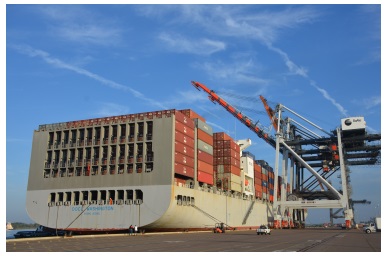
OOCL Washington loading and unloading containers at JAXPORT’s TraPac Container Terminal on April 22, 2017.
Photo/JAXPORT
Double-Digit Growth continues JAXPORT’s Asian Container Trade

OOCL Washington loading and unloading containers at JAXPORT’s TraPac Container Terminal on April 22, 2017.
Photo/JAXPORT
JAXPORT’s Asia container trade jumped 13 percent during the first six months of fiscal year 2016-17, to 178,249 TEUs from 157,689 in first half FY 2015-16. The trade has grown by an average 23 percent annually for the past five years. JAXPORT’s fiscal year runs from October 1 through September 30.
Asia now accounts for 36 percent of JAXPORT’s container business, up from 33 percent a year ago and just 7 percent in FY 2013-14.
JAXPORT enjoys direct liner service links with Asia via the Panama and Suez Canals. The three largest ocean carrier consortia THE Alliance, 2M and Ocean Alliance all serve JAXPORT.
A federal project to deepen the Jacksonville shipping channel to 47 feet will offer the largest container ships calling on the U.S. East Coast unobstructed access to the port’s terminals.
JAXPORT continues to invest in infrastructure upgrades including a new on-dock rail facility, new 100-gauge container cranes and ongoing enhancements to terminal berths, docks and rail.
Mexico: First Quarter Growth for Cargo and Cruise Traffic
Mexico’s port system processed just over 73.0 million metric tons of cargo during first quarter 2016, an increase of 6.1 percent from a year ago, according to "preliminary" data compiled and reported by the federal port agency, Coordinación General de Puertos y Marina Mercante.
Imports accounted for 28.9 million tons ( 18.3 percent), exports for 29.0 million tons ( 0.4 percent) and domestic shipments for 15.1 million tons (-2.3 percent).
The first quarter was marked by double-digit growth for containerized and breakbulk cargo, more modest gains by mineral bulks, petroleum, and non-petroleum liquids, and a decline for agribulks.
Other data point to robust growth for container TEUs and the auto trade, both imports and exports.
Double-digit jumps in vessel arrivals and passenger throughput made it a prosperous quarter as well for Mexico’s cruise sector.
The attachment provides additional detail.